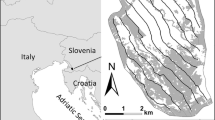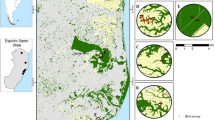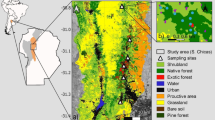Abstract
Montados form a heterogeneous landscape of wooded matrix dominated by cork and/or holm oak with open areas characterized by fuzzy boundaries. Montado supports a high biological diversity associated to low intensity management and a landscape diversity provided by a continuous gradient of land cover. Among other features this permits the classification of montados as a High Nature Value (HNV) system. We assessed the role of birds as HNV indicators for montado, and tested several bird groups—farmland, edge, forest generalists and forest specialists species; and some universal indicators such as species conservation status, Shannon’s diversity index and species richness. Our study areas covered the North–South distribution of cork oak in Portugal, and we surveyed the breeding bird communities across 117 sampling sites. In addition to variables related to management and sanitary status, we considered variables that characterize the landscape heterogeneity inside the montado—trees and shrub density and richness of woody vegetation. Our results suggest that specific bird guilds can be used as HNV indicators of particular typologies of montado, and highlight the need to develop an indicator that could be transversally applied to all types of montado.


Similar content being viewed by others
References
Andersen E, Baldock D, Bennett H, Beaufoy G, Bignal E, Brouwer F, Elbersen B, Eiden G, Godeschalk F, Jones G, McCracken D, Nieuwenhuizen W, van Eupen M, Hennekens S, Zervas G (2003) Developing a High Nature Value Farming area indicator. Internal report for the European Environment Agency.
APCOR (2012) Anuário da APCOR. Plenimagem
Barton K (2014) Multi-model inference. Version 1.10.0. http://cran.r-project.org/web/packages/MuMIn/index.html. Accessed 24 Sept 2014
Beaufoy G, Cooper T (2008) Guidance document to the member states on the application of the Hight Nature Value impact indicator. Institute for European Environmental Policy, Brussels
Bibby CJ, Burgess ND, Hill DA, Mustoe S (2000) Bird census techniques, 2nd edn. Academic Press, London
BirdLife International (2004) Birds in the European Union: a status assessment. BirdLife International, Wageningen
BirdLife International (2014) IUCN Red List for birds. http://www.birdlife.org. Accessed 4 Aug 2014
Blondel J, Aronson J (1999) Biology and wildlife of the Mediterranean region. Oxford University Press, New York
Burnham KP, Anderson DR (2002) Model selection and multimodel inference: a practical information-theoretic approach. Springer, New York
Cabral MT, Ferreira MC, Moreira T, Carvalho EC, Diniz AC (1992) Diagnóstico das causas da anormal mortalidade dos sobreiros a Sul do Tejo. Scientia Gerundensis 18:205–214
Cabral M, Almeida J, Almeida P, Dellinger T, Almeida N, Oliveira M, Palmeirim J, Queiroz A, Rogado L, Reis M (2005) Livro Vermelho dos Vertebrados de Portugal. Instituto da Conservação da Natureza, Lisboa
Carreiras JMB, Pereira JMC, Pereira JS (2006) Estimation of tree canopy cover in evergreen oak woodlands using remote sensing. For Ecol Manag 223:45–53
DGRF (2007) Inventário Florestal Nacional 2005/06. Direcção Geral dos Recursos Florestais, Lisboa
Díaz M, Pulido FJ, Marañón T (2003) Diversidad biológica y sostenibilidad ecológica y económica de los sistemas adehesados. Ecossistemas XII (3)
Godinho C, Rabaça JE (2011) Birds like it Corky: the influence of habitat features and management of ‘montados’ in breeding bird communities. Agrofor Syst 82(2):138–195
Harrop SR (2007) Traditional agricultural landscapes as protected areas in international law and policy. Agric Ecosyst Environ 121(3):296–307
Hoffmann J, Greef JM (2003) Mosaic indicators—theoretical approach for the development of indicators for species diversity in agricultural landscapes. Agric Ecosyst Environ 98(1–3):387–394
Hoogeveen Y, Petersen J-E, Balazs K, Higuero I (2004) High Nature Value farmland: characteristics, trends and policy challenges. European Environment Agency, Luxembourg
IBMCorp. (2012) IBM SPSS Statistics for Windows, Version 21.0. IBM Corp., Armonk, NY
Imbeau L, Drapeau P, Mönkkönen M (2003) Are forest birds categorised as “edge species” strictly associated with edges? Ecography 26(4):514–520
Joffre R, Rambal S, Ratte JP (1999) The dehesa system of southern Spain and Portugal as a natural ecosystem mimic. Agrofor Syst 45(1–3):57–79
Kleijn D, Kohler F, Báldi A, Batáry P, Concepción ED, Clough Y, Díaz M, Gabriel D, Holzschuh A, Knop E, Kovács A, Marshall EJP, Tscharntke T, Verhulst J (2009) On the relationship between farmland biodiversity and land-use intensity in Europe. Proc R Soc B 276(1658):903–909
Leal AI, Correia RA, Granadeiro JP, Palmeirim JM (2011) Impact of cork extraction on birds: relevance for conservation of Mediterranean biodiversity. Biol Conserv 144(5):1655–1662
Lukacs PM, Burnham KP, Anderson DR (2010) Model selection bias and Freedman’s paradox. Ann Inst Stat Math 62:117–125
Moreira F, Beja P, Morgado R, Reino L, Gordinho L, Delgado A, Borralho R (2005) Effects of field management and landscape context on grassland wintering birds in Southern Portugal. Agric Ecosyst Environ 109(1–2):59–74
Morelli F (2013) Relative importance of marginal vegetation (shrubs, hedgerows, isolated trees) surrogate of HNV farmland for bird species distribution in Central Italy. Ecol Eng 57:261–266
Ojeda F, Arroyo J, Marañón T (1995) Biodiversity components and conservation of mediterranean healthlands in Southern Spain. Biol Conserv 72(1):61–72
Pereira P, Godinho C, Roque I, Marques A, Branco M, Rabaça JE (2014) Time to rethink the management intensity in a Mediterranean oak woodland: the response of insectivorous birds and leaf-chewing defoliators as key groups in the forest ecosystem. Ann For Sci 71(1):25–32
Pérez-Tris J, Bensch S, Carbonell R, Helbig A, Tellería J (2004) Historical diversification of migration patterns in a passerine bird. Evolution 58(8):1819–1832
Pinheiro JC, Bates DM (2000) Mixed-effects models in S and S-PLUS. Springer, New York
Pinheiro J, Bates D, DebRoy S, Sarkar D and R Core Team (2014) nlme: Linear and nonlinear mixed effects models. R package version 3.1-117, http://CRAN.R-project.org/package=nlme. Accessed 24 Sept 2014
Pinto-Correia T (1993) Threatened landscape in Alentejo, Portugal: the ‘montado’ and other ‘agro-silvo-pastoral’ systems. Landsc Urban Plan 24(1–4):43–48
Pinto-Correia T, Almeida M (2013) Tentative identification procedure for HNV Montados. In: ICAAM International Conference 2013: Acknowledging the MONTADOS and DEHESAS as High Nature Value Farming Systems, Évora, Portugal, 6–8 February.
Pinto-Correia T, Vos W (2004) Multifunctionality in Mediterranean landscapes–past and future. New Dimens Eur Lands 4:135–164
Pinto-Correia T, Ribeiro N, Sá-Sousa P (2011) Introducing the montado, the cork and holm oak agroforestry system of Southern Portugal. Agrofor Syst 82(2):99–104
Plieninger T (2007) Compatibility of livestock grazing with stand regeneration in Mediterranean holm oak parklands. J Nat Conserv 15(1):1–9
Rabaça JE (1990) The influence of shrubby understory in breeding bird communities of cork oak (Quercus suber) woodlands in Portugal. Portugaliae Zoologica 1(1):6
RCoreTeam (2013) A language and environment for statistical computing. R Foundation for Statistical Computing, Vienna, Austria
Reino L, Beja P, Osborne PE, Morgado R, Fabião A, Rotenberry JT (2009) Distance to edges, edge contrast and landscape fragmentation: interactions affecting farmland birds around forest plantations. Biol Conserv 142(4):824–838
Scarascia-Mugnozza G, Oswald H, Piussi P, Radoglou K (2000) Forests of the Mediterranean region: gaps in knowledge and research needs. For Ecol Manag 132(1):97–109
Storch I, Woitke E, Krieger S (2005) Landscape-scale edge effect in predation risk in forest-farmland mosaics of Central Europe. Landsc Ecol 20(8):927–940. doi:10.1007/s10980-005-7005-2
Symonds MR, Moussalli A (2011) A brief guide to model selection, multimodel inference and model averaging in behavioural ecology using Akaike’s information criterion. Behav Ecol Sociobiol 65(1):13–21
Tabachnick BG, Fidell LS (2001) Using multivariate statistics. Allyn and Bacon, Boston
Tavares JP (2009) Uma perspectiva internacional sobre as prioridades de conservação da avifauna Portuguesa. Actas do VI Congresso de Ornitologia da Sociedade Portuguesa para o Estudo das Aves. Elvas
Tellería JL (2001) Passerine bird communities of Iberian dehesas: a review. Anim Biodivers Conserv 24(2):67
Telleria JL, Baquero R, Santos T (2003) Effects of forest fragmentation on European birds: implications of regional differences in species richness. J Biogeogr 30:621–628
Whelan CJ (2001) Foliage structure influences foraging of insectivorous forest birds: an experimental study. Ecology 82:219–231
Willson MF (1974) Avian community organization and habitat structure. Ecology 55:1017–1029
Zar JH (1999) Biostatistical analysis, 4th edn. Prentice Hall, New Jersey
Acknowledgments
We would like to thank two anonymous reviewers whose comments helped to improve the manuscript. We also thank to Rui Lourenço, Pedro Salgueiro and Luís Gomes for invaluable comments and suggestions. This study was partially supported by Companhia das Lezírias S.A. and by the Portuguese Science Foundation through the Doctoral grants SFRH/BD/81602/2011 (Carlos Godinho) and SFRH/BD/87340/2012 (Pedro Pereira).
Author information
Authors and Affiliations
Corresponding author
Electronic supplementary material
Below is the link to the electronic supplementary material.
Rights and permissions
About this article
Cite this article
Catarino, L., Godinho, C., Pereira, P. et al. Can birds play a role as High Nature Value indicators of montado system?. Agroforest Syst 90, 45–56 (2016). https://doi.org/10.1007/s10457-014-9761-y
Received:
Accepted:
Published:
Issue Date:
DOI: https://doi.org/10.1007/s10457-014-9761-y




